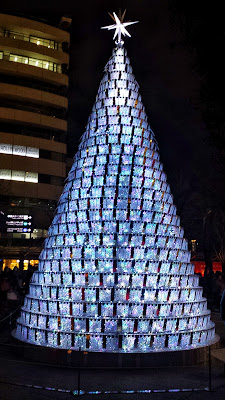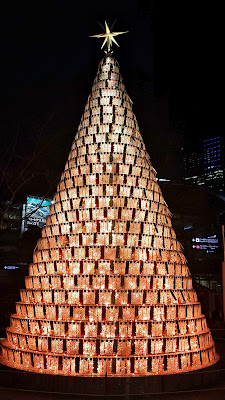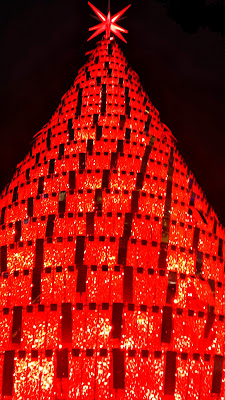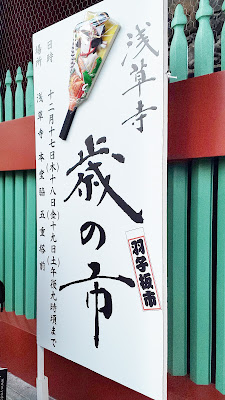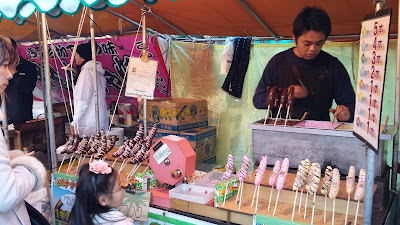During our first week staying in Japan, we stayed in Shinjuku, a busy area known for lots of shopping, entertainment, and Shinjuku Station is Japan’s busiest railway station. This was great for us in that it was super easy to get food and drink (varying from department stores to lots of restaurants and nightlife establishments), and the train station is a hub for many train lines.
So it was very easy to decide that morning to take a day trip to Mount Takao, or on another day, we took a day trip to Yokohama and made it a Ramen Day! Our first stop was visiting Cup Noodles Museum, also known as the Momofuku Ando Instant Ramen Museum. This is one of the 2 branches of the museum – the other is in Osaka.
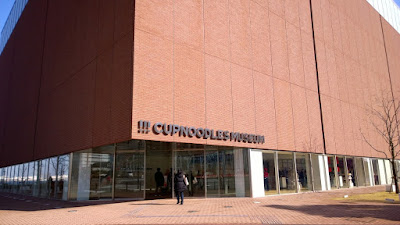
Not far from Tokyo – about 40 km south, or about an hour by train, is the city of Yokohama. If you recall vaguely from your history books, this is the fishing village that became the epicenter of foreign trade when Commodore Matthew Perry landed around here in 1853 and Japan opened itself for the first time to the outside world. Today, Yokohama is the second largest city outside, and the foreign influence shows in that is a port town, and it is also home to the largest Chinatown in Japan. It is still home to lots of trade and visitors, though now the focus is more on amusement and tourism then foreign trade and military presence. This includes the Cup Noodles Ramen Museum, Cosmo World Amusement Park, Hakkeijima Sea Paradise aquarium and amusement park, Kirin Beer Village, and other activities. You could easily spend a whole day, and it would be a great family trip together.
As you are walking from the train station to the Cup Noodles Ramen Museum in Yokohama, you won’t help but notice the huge Cosmo Clock 21, at one point the tallest ferris wheel in the world and the world’s largest clock with a height of 112.5 m / 369 ft and diameter of 100 m / 330 ft and 60 cars each carrying 8 people. The presence of the tall ship as we walked along the waterfront past Cosmo World was a modern nod to the ships that might have docked in the area more than 150 years ago. Other modern skyscrapers also compliment the skyline here.


Both Cup Noodles museums in Yokohama and Osaka have an instant ramen workshop allowing visitors to make their own “fresh” instant noodles (fresh as in just made the noodles at least!). Reservations must be made in advance for this fresh ramen making activity called Chicken Ramen Factory. There is also a My Cupnoodles Factory where visitors can assemble their own personal Cup Noodles from pre-made ingredient
At least in the Momofuku Ando Instant Ramen Museum we visited – there are 5 floors of ramen fun. Well, really only 4 since the 5th is for events. The 1st floor is the Museum Shop, 2nd is a theater explaining the history of instant ramen’s invention, the 3rd has activities like making ramen noodles or your personal Cup Noodles, and the 4th is a Noodles Bazaar with various ramen from around the world to eat in a food hall.


The way of the flow of the museum goes, you start with the history area, which is on the second floor since the first floor is the lobby with Entrance Hall to buy your admission or make activity reservations and the Museum Shop.
Visiting Cup Noodles Museum – Second Floor
It’s a pretty cool visual sight to see what they dub the Instant Noodles History Cube that displays the original Cup Noodles Chicken Ramen from 1958 through the approximately 800 product packages that were created to now. The breadth and depth of different packages really demonstrates how a single product has grown to the 100 billion servings of instant noodles that are consumed every year around the world now.
It’s fascinating seeing the various flavors that have been created and changes in marketing over time and how it varies internationally.
You can then watch a 15 minute film about the history in the Momofuku Theater of how Momofuku Ando came up with the idea for instant noodles. It is a pretty fun film using animation with big bobble headed versions of people and a little humor to walk through the thoughts that led up to the invention of instant ramen and then of Cup Noodles.

Momofuku Ando invented the world’s first instant noodles, Chicken Ramen, in 1958 after an entire year of research using common tools in a little shed he had constructed in the backyard of his house. Right after the short film, a wall opens to a narrative timeline of the instant ramen invention (Creative Thinking Rooms) that starts out with a replica of his little shed (Momofuku Work Shed). You can step right into the shed, which is very humbling to see as the origin of such a vast empire and a savior to many a poor student. The giant wok pot of oil he was experimenting with definitely seemed to be very unsafe lab conditions for the year while he was inventing instant ramen!
One of the things I really enjoyed about the museum is also the philosophy it tries to teach to its visitors. Momofuku Ando was 48 years old when he started Cup Noodles. It involved a huge bounce back from personal hardships which they kept sort of vague, but I found he was raised by his grandparents because his parents died when he was an infant, and as an adult he went to jail convicted of tax evasion in the form of providing scholarships to students, and his company went bankrupt and he lost all his assets except his house.
There is no such thing as too late in life and don’t give up, the museum tries to message. Given the era of time this was also in (end of WW II), you can see how this optimism was really reflective of the rebuilding the whole country was going through too.
The museum aesthetic is very clean, simple design reflected throughout the museum rooms except in the Noodles Bazaar. This is reflective of the museum’s other message that you don’t need fancy or expensive facilities to research and invent things because it’s the knowledge in your head that’s important. The museum goes into detail in finding inspiration from every day things and thinking outside the box. Charming doodle like drawings accompany the narrative from the original instant noodle ramen invention in 1958 to the Cup Noodles initial invention in 1971 to Cup Noodles for consumption in outer space and carried on the Space Shuttle Discovery. It does seem though those who know Japanese get a lot more info than those who just know English from the placards.
Visiting Cup Noodles Museum – Third Floor
On the next floor is the area for the Chicken Ramen Factory I had mentioned earlier where you done bright yellow bandannas with the Nissin chick mascot on it and make noodles, as well as the area where you make your own custom Cup Noodles – My Cupnoodles Factory. It’s pretty cheap to sign up for the custom Cup Noodles experience and it will only cost you 300 yen. The admission is for set times during the day, so make sure you keep an eye out for when your time slot is. As you can see, this is appropriate for pretty much ALL ages.
There’s just 8 steps to the process:
Get a cup from the vending machine (300 yen) and sanitize your hands.
You will be directed to empty seats at communal tables that have markers to decorate your cup. You will also see a preview of the ingredients you can choose to fill your custom cup with a custom ramen noodle combination. There are four varieties of soup and you get to choose four toppings from among 12 ingredients. Don’t worry, there is a lid on your cup as you are decorating to keep it uncontaminated inside.
Next you will be directed to one of the lines to fill your cup. I have to hand it to the ladies who man those cup filling stations, they were super cheerful and patient with guests of all ages and languages, and always had a bright smile on their faces and clear gestures to show you the process. In the first part, you will turn a lever to place the noodle cup over the already flash fried noodles upside down – one of the big discoveries as part of the Cup Noodles invention. By putting it upside down, the noodles don’t get stuck when you drop into the cup and mess up the assembly line.
The designer in me loved the clear simple explanation in multiple languages on the glass of each station, and when you’ve reached the end of turning the cup to place the noodles in the right part, the crank gives this satisfying click and you can feel it click in the handle too.
Now you choose one soup flavor from among 4 varieties and four toppings from among 12 ingredients. Altogether, there are 5,460 flavor combinations possible! Soup flavors include original, seafood, curry or chili tomato. Ingredient options include kidney beans, crab flavored fish sausage, corn, shrimp, egg, cubic roast pork, garlic chips, kimchee, Hiyoko-chan fish sausage (the chicken face chips), cheddar cheese, and green onion, and one seasonal limited edition additional ingredient that varies.
The next portions the staff perform for you to observe – the packaging of the cup where you seal the cup,
then you shrink wrap the cup
Then you inflate a protective bag using an air pump
Now you can wear it as a ridiculous necklace accessory.
Visiting Cup Noodles Museum – Fourth Floor
The Fourth Floor is the Noodles Bazaar, which is essentially a food court offering instant ramen flavors from around the world at various stations that you then eat in an open cafeteria area. Our goal was to go to another Ramen Museum which had ramen representations of different prefectures o eat, so I only have a few pictures to show you the atmosphere here since we didn’t eat any ramen.
So, what did you think of this Ramen Adventure part 1? Is it what you expected from an Instant Ramen museum? Would you visit this museum or not, and what would you decorate or choose for ingredients in your custom Cup Noodles cup?
Next week- Ramen Adventure part 2 to Shin-Yokohama Raumen Museum.
If you’d like to read a little more on Momofuku Ando, it was his 105th birthday on March 5 2015 and Google had a cute doodle for him you can read here!

Here’s a summary of my Japan Travel post series:
- Guide to Planning a Trip: Research
- Guide to Planning a Trip: Mapping
- Hagoita Ichi Winter Festival at Sensoji Temple, Japan
- Japanese Treats at Temples and Shrines
- Winter Illuminations in Tokyo (Winter Season – November – February!)
- Snow Monkeys in Hot Springs
- Onsen by Mount Fuji covers Onsen 101 and how we loved our stay at Lake Kawaguchiko
- Dining at a Ryokan a look at what a traditional dinner and breakfast might be during a ryokan stay
- Visiting Cup Noodles Museum in Yokohama (just outside Tokyo)
- Visiting Shin Yokohama Ramen Museum
- Kyoto Temples and Shrines (walking tour starting in Higashimaya with stops especially at Kiyomizudera Temple, Kodaji Temple, Heian Shrine)
- Kyoto Temples in Arashiyama
- Kyoto Tofu
- Kyoto Famous Sights of the Kinkakuji (The Golden Pavilion) and Fushimi Inari (Red Torii Gates)
- Famous Signs of Osaka and eating Osaka Food specialities like okonomiyaki, takoyaki and kushikatsu
- Visiting Himeji Castle, the famous white castle in Japan
- Fun at Japanese Cafes and More including Maid Cafe, Cat Cafe; theme parks of J World and Namja Town, a geeky stop at Kanda Myojin, and Ghibli Museum
- Japan Eating Checklist is my top 25 list of things to try to include as an eating experience when visiting Japan
- New Year’s in Japan: Oji Fox Parade, and some photos of a Meiji Shrine visit on New Year’s Day











